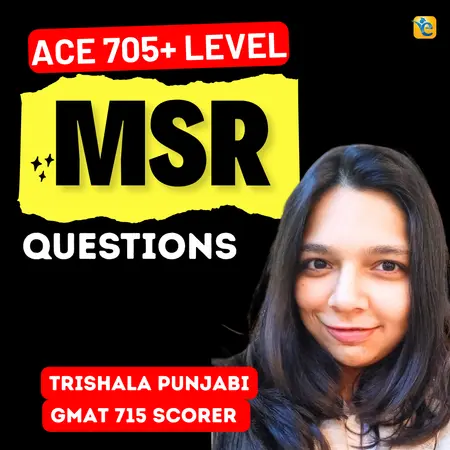Events & Promotions
|
|

GMAT Club Daily Prep
Thank you for using the timer - this advanced tool can estimate your performance and suggest more practice questions. We have subscribed you to Daily Prep Questions via email.
Customized
for You
Track
Your Progress
Practice
Pays
Not interested in getting valuable practice questions and articles delivered to your email? No problem, unsubscribe here.
- Nov 18
11:00 AM PST
-12:00 PM PST
Join us in a live GMAT practice session and solve 30 challenging GMAT questions with other test takers in timed conditions, covering GMAT Quant, Data Sufficiency, Data Insights, Reading Comprehension, and Critical Reasoning questions. - Nov 22
11:00 AM IST
-01:00 PM IST
Do RC/MSR passages scare you? e-GMAT is conducting a masterclass to help you learn – Learn effective reading strategies Tackle difficult RC & MSR with confidence Excel in timed test environment - Nov 23
11:00 AM IST
-01:00 PM IST
Attend this free GMAT Algebra Webinar and learn how to master the most challenging Inequalities and Absolute Value problems with ease. - Nov 25
10:00 AM EST
-11:00 AM EST
Prefer video-based learning? The Target Test Prep OnDemand course is a one-of-a-kind video masterclass featuring 400 hours of lecture-style teaching by Scott Woodbury-Stewart, founder of Target Test Prep and one of the most accomplished GMAT instructors.
C
Be sure to select an answer first to save it in the Error Log before revealing the correct answer (OA)!
Difficulty:
 85%
(hard)
85%
(hard)
Question Stats:
33% (01:03) correct 67%
(01:03)
wrong
67%
(01:03)
wrong  based on 4792
sessions
based on 4792
sessions
History
Date
Time
Result
Not Attempted Yet
If A, then B.
If B, then C.
If C, then D.
If all of the statements above are true, which of the following must also be true?
(A) If D, then A.
(B) If not B, then not C.
(C) If not D, then not A.
(D) If D, then E.
(E) If not A, then not D.
If B, then C.
If C, then D.
If all of the statements above are true, which of the following must also be true?
(A) If D, then A.
(B) If not B, then not C.
(C) If not D, then not A.
(D) If D, then E.
(E) If not A, then not D.
Why is the official answer C ?
For example, choice B could be correct too. If not B then not C.
For example, choice B could be correct too. If not B then not C.
Kudos
Bookmarks
utin
Ok, consider a simple example:
If I eat dinner now, I will eat dessert later. (A -> B)
You're told this is a TRUE statement - in other words, eating dinner absolutely, positively, no question about it, 100% results in eating dessert after. There's no possible situation that can exist where I will eat dinner now and then NOT eat dessert later.
Now consider the below statements:
If don't eat dessert later, I didn't eat dinner now. (contrapositive: ~B -> ~A)
Since we KNOW FOR A FACT that eating dinner now results in eating dessert later, we can conclude without a doubt that if I don't eat dessert, I most definitely did not eat dinner (because if I had eaten dinner, I would have eaten dessert). This is called the contrapositive and is logically equivalent to the original statement. (This is answer C)
If I don't eat dinner now, I won't eat dessert later. (inverse: ~A -> ~B)
We know for a fact that eating dinner will lead to eating dessert. However, we know absolutely nothing about the result of NOT eating dinner. I didn't say to you that I would ONLY eat dessert if I eat dinner first - only that I would definitely eat it after eating dinner. This statement is not logically equivalent to the original. This is called the inverse, and is answer B.
Does this help?
Kudos
Bookmarks
I learned this today (forgot the original poster but kudos to him). His/her quote went as
If A then B , could be rephrased as if Not B then Not A and if B then may be A.
Take the example of: If I am in France, I am in Europe
If I am not in Europe, I am not in France. ( Not B then Not A)
If I am in Europe, I may be in France ( B then may be A).
All other violate this logical rule or add extra information.
So in the given example by reversing all the signs we get....
~D => ~C
~C => ~B
~B => ~A
Thus simply substituting....
~D => ~A
If A then B , could be rephrased as if Not B then Not A and if B then may be A.
Take the example of: If I am in France, I am in Europe
If I am not in Europe, I am not in France. ( Not B then Not A)
If I am in Europe, I may be in France ( B then may be A).
All other violate this logical rule or add extra information.
So in the given example by reversing all the signs we get....
~D => ~C
~C => ~B
~B => ~A
Thus simply substituting....
~D => ~A












